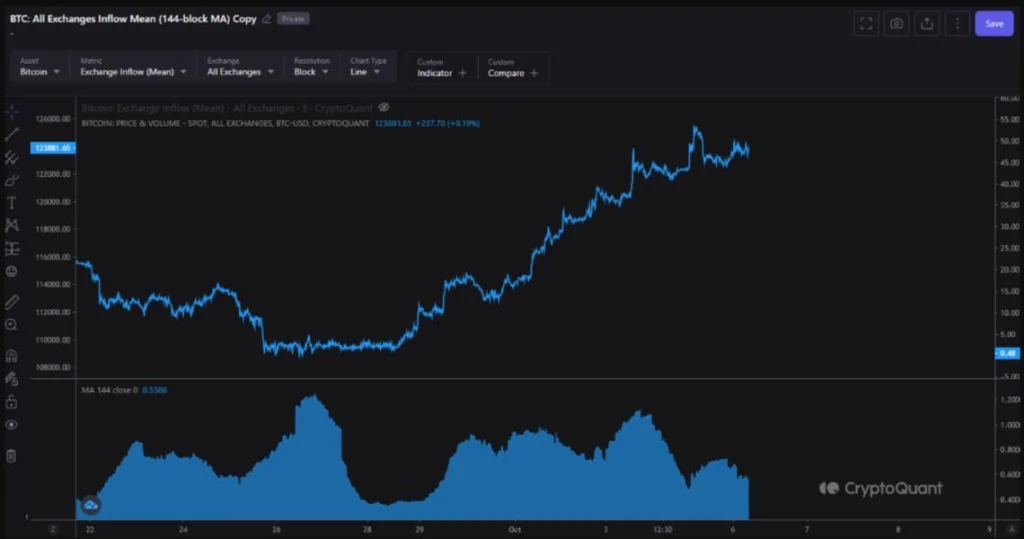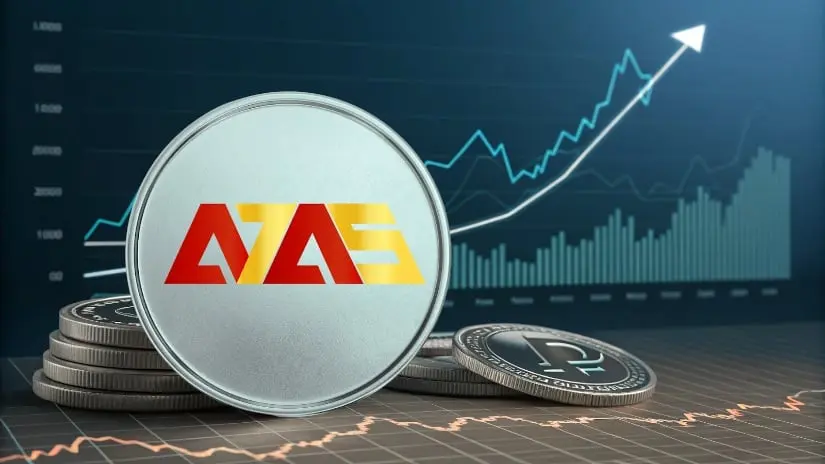
This week of October marked one of the busiest periods of the year for the crypto market.
Bitcoin reached a new all-time high of $126,000, driven by strong inflows into U.S. Bitcoin ETFs and the growing presence of institutional investors. Meanwhile, Ethereum and BNB followed the same upward trend, reinforcing the widespread optimism that spread across major cryptocurrencies.
At the same time, the global landscape remains tense: the U.S. Congress faces a stalemate over a bill that would define which agency — SEC or CFTC — will oversee the crypto sector, while the market awaits the SEC’s decision on Solana spot ETFs, which could open a new chapter for altcoins.
Between record highs, regulatory disputes, and institutional progress, this week showed why the crypto market is hotter than ever — and in this article, you’ll find everything that moved Bitcoin, altcoins, and the key decisions shaping the industry’s direction in 2025.
Bitcoin Hits New Record of $126,000 with Strong ETF Inflows

Source: Crypto Quant
Bitcoin (BTC) surpassed the historic mark of $126,000 on Monday (6), setting a new all-time high and reaffirming the strength of the current bull cycle.
According to CoinMarketCap data, the asset later saw a mild correction, trading around $124,335 — a move interpreted as a technical pause after several weeks of steady gains.
Bitcoin ETFs Record $1.21 Billion in Inflows — 2nd Largest in History
Bitcoin ETFs in the United States saw a massive $1.21 billion in inflows in a single day — the second-largest daily volume on record.
The previous record of $1.37 billion was set on November 7, 2024, shortly after Donald Trump’s election victory.
Among the funds, BlackRock’s IBIT led with $969 million, followed by Fidelity’s FBTC with $112 million, and Bitwise’s BITB with $60 million.
This movement highlights the growing institutional demand for Bitcoin, particularly through regulated and easily accessible investment vehicles such as spot ETFs.
Analysts See a Structured Rally but Warn of Technical Consolidation
According to analysts from BRN, Bitcoin’s 2025 rally is supported by lower leverage positions and a more solid market structure, reducing the risk of mass liquidations.
Still, experts consider a short-term consolidation between $123,000 and $126,000 healthy before a potential new surge toward $130,000–$135,000.
This outlook suggests that the current uptrend is more organic and sustainable, reflecting the advance of institutional adoption and the direct impact of ETFs on market liquidity.
Altcoins Rise Too: BNB and Ethereum Lead the Pack
Market optimism also spread to other major cryptocurrencies:
- BNB (Binance Coin) jumped 6.2%, reaching $1,293, its highest price ever.
- Ethereum (ETH) rose 3%, hitting $4,694, driven by new inflows into DeFi platforms and anticipation around network upgrades.
The performance of altcoins reinforces the historical pattern where strong Bitcoin rallies tend to attract capital across the broader crypto market.
Why This Bitcoin Record Matters
The strong capital inflows into ETFs reinforce the view that the cryptocurrency market is maturing.
The growing presence of major financial institutions like BlackRock and Fidelity enhances credibility and lowers the entry barriers for traditional investors.
As a result, Bitcoin continues to strengthen its role as a digital reserve asset, attracting new waves of investors seeking protection against economic instability and inflation.
Bitcoin Falls to $120,000 as Gold and Stocks Hit New Highs

Source: Cointelegraph
Bitcoin (BTC) dropped about 1.8% in the past 24 hours, trading around $123,468 after recently reaching its all-time high of $126,000.
Despite the slight pullback, BTC still shows a 1.5% gain for the week and 7.6% for the month, indicating that the correction comes after a strong rally in recent weeks.
While Bitcoin sees profit-taking, traditional markets continue to climb — with gold, silver, and U.S. stocks all hitting new record highs, driven by positive economic expectations and cautious monetary policies.
Bitcoin Shows Temporary Weakness After Record Highs
After weeks of strong gains, Bitcoin is showing signs of a natural technical correction.
According to CryptoQuant analysts, the cryptocurrency has underperformed compared to stocks and precious metals, signaling a healthy pause in the bullish cycle.
“To confirm a real trend reversal, we’d need to see consistent declines over several days,” said analyst Maartunn.
Even so, BTC remains only 3.8% below its all-time high, suggesting that the current movement may simply be a consolidation phase before another potential upward leg.
Gold and Stocks Surge, Outperforming Bitcoin
While BTC cools off, traditional markets are surging:
- Gold surpassed $4,000 per ounce for the first time in history;
- Silver climbed to $51 per ounce;
- S&P 500 and Nasdaq 100 both set new record highs in New York.
Since the start of 2025, gold has gained 53%, while Bitcoin has risen about 29%, moving from $94,000 to its recent peak.
This contrast shows that, in the short term, traditional assets remain preferred as safe havens, especially during periods of monetary uncertainty.
Fed’s Lack of Clarity Fuels Investor Caution
Federal Reserve Chair Jerome Powell recently gave a speech without directly addressing the U.S. economic outlook.
This lack of clear signals regarding interest rates, inflation, and liquidity increased volatility across markets — pushing some investors toward gold and equities for protection, while temporarily reducing appetite for crypto assets.
Global Record: Crypto ETFs Receive $5.95 Billion in a Single Week

According to a Reuters report, the cryptocurrency market hit a historic milestone at the beginning of October: crypto asset ETFs attracted $5.95 billion in global inflows within just seven days — the largest weekly volume ever recorded.
The main highlight was Bitcoin (BTC), which accounted for $3.55 billion in new investments through ETFs.
This surge reflects the strong institutional appetite for Bitcoin exposure, driven by its recent price appreciation and growing expectations that the asset could reach new highs by the end of the year.
Ethereum (ETH) also stood out, with $1.48 billion flowing into its ETFs. The rising demand for ETH-related products signals increased investor interest in smart contracts, staking, and DeFi applications — all rapidly expanding sectors within the Ethereum ecosystem.
Experts note that this record-breaking inflow marks a shift in the crypto market’s profile: institutional investors are increasingly turning to regulated ETFs as a safer entry point, reducing reliance on centralized exchanges and strengthening the legitimacy of digital assets within traditional financial markets.
Solana ETF Could Be Approved and Shake Up the Crypto Market

The U.S. Securities and Exchange Commission (SEC) is expected to decide this Friday (10) on the possible approval of the first spot Solana (SOL) ETFs.
The decision could mark a new milestone for the crypto market, expanding institutional access to the Solana blockchain and potentially boosting the token’s price.
Asset managers such as VanEck, 21Shares, Bitwise, and Franklin Templeton are among those awaiting the green light.
Bitcoin and Solana Slip Slightly Ahead of the Decision
As the market waits for the SEC’s verdict, major cryptocurrencies are seeing mild corrections:
- Bitcoin (BTC) is down about 0.4%, trading around $121,354;
- Solana (SOL) dropped 1%, priced at $219.77;
- BNB (Binance Coin) leads losses among the top 10 crypto assets, falling 2.1%.
Despite the short-term dip, investors believe that a Solana ETF approval could reverse the cautious sentiment and spark a new bullish cycle in the market.
What Is a Spot Solana ETF?
A spot ETF is an exchange-traded fund that holds the underlying asset directly — in this case, the SOL token.
This allows investors to gain regulated exposure to Solana without the need to buy or self-custody the cryptocurrency.
Like previously approved Bitcoin and Ethereum ETFs, Solana ETFs could:
- Expand institutional access to crypto;
- Increase liquidity and recognition of the asset;
- Serve as a new benchmark for altcoin adoption on Wall Street.
Why This Decision Matters for the Crypto Market
The potential approval of Solana ETFs reinforces a clear trend: the institutional tokenization movement and the integration of digital assets into traditional finance.
Since the approval of Bitcoin and Ethereum ETFs, investors have been eager to see which asset will be next on the SEC’s regulatory radar.
If confirmed, Solana could become the third major institutionalized cryptocurrency, following BTC and ETH.
U.S. Senate Deadlock Stalls New Crypto Bill
According to a report by Politico, the United States Senate is facing a deadlock over a bill that aims to define the regulatory responsibilities of the crypto market, particularly between the SEC (Securities and Exchange Commission) and the CFTC (Commodity Futures Trading Commission).
The bill seeks to establish clear boundaries between the two agencies — an issue that has caused legal uncertainty for blockchain companies, institutional investors, and DeFi projects for years.
In practice, the proposal attempts to answer a central question: “Who should oversee digital assets — the SEC, responsible for securities, or the CFTC, which regulates derivatives and commodities?”
However, political divisions between Democrats and Republicans are stalling progress. While Republicans advocate for clearer and lighter rules to promote innovation and competitiveness, Democrats call for stronger investor protection and tighter oversight of tokens that function as investment securities.
The debate intensified following the surge in institutional adoption and the growth of DeFi protocols, which move billions of dollars outside the traditional banking system. Regulating the next generation of decentralized finance has become one of the most sensitive topics in Washington — especially in a pre-election year.
Russian Token A7A5 Defies Sanctions and Sponsors Global Conference

Source: Brave New Coin
During the TOKEN2049 conference in Singapore, an unusual incident caught the crypto market’s attention: the ruble-backed token A7A5, which is under U.S. and U.K. sanctions, appeared as an official sponsor of the event — one of the largest gatherings in the global cryptocurrency industry.
The news raised concerns among regulators and participating companies, as the presence of a sanctioned asset at such a major international event brings compliance and due diligence into question within the crypto industry.
A7A5 Moves Over $6 Billion Since August
According to the Financial Times, despite the restrictions, A7A5 has processed more than $6 billion in transactions since August 2025. Analysts report that the token — supposedly backed by the Russian ruble and linked to institutions close to the Kremlin — has been using sophisticated tactics to obscure its traces, making it difficult to track transactions and identify wallets associated with sanctioned entities.
These movements suggest that A7A5 may be used to circumvent international financial sanctions, acting as an alternative liquidity tool outside the traditional banking system.
The episode reignites the discussion on how digital assets can be exploited by sanctioned states and how blockchain transparency can be challenged by privacy technologies and decentralized protocols.
CZ Zhao Warned by Google of “Government-Backed” Hacker Attack

Source: X
Zhao shared on X (Twitter) that he received a Google alert saying “government-backed attackers may be trying to steal your password.”
He added that such warnings appear “once in a while,” suggesting repeated attempts by advanced hacker groups possibly linked to North Korea’s Lazarus Group.
The Lazarus Group, one of the most notorious state-sponsored hacking organizations, has been blamed for some of the largest crypto thefts in history. In 2024 alone, the group reportedly stole over $1.34 billion in digital assets — double the amount stolen in 2023.
Who Is Behind the Attack?
While Google did not confirm the source, Zhao hinted that the Lazarus Group could be responsible.
This cybercrime network, believed to be backed by the North Korean government, specializes in infiltrating crypto exchanges, DeFi platforms, and blockchain developers through:
- Phishing attacks targeting executives and developers.
- Fake job applications using forged resumes to gain internal access to crypto companies.
- Malware-infected documents sent via email or LinkedIn.
According to the cybersecurity firm SEAL, at least 60 North Korean operatives are currently posing as IT professionals to infiltrate U.S.-based crypto projects.
Why Does It Matters?
The alert to Zhao underscores how state-backed cyber threats are becoming more frequent and sophisticated — especially targeting high-profile individuals and centralized exchanges that hold large volumes of digital assets.
The growing number of attacks suggests that national-level hacking campaigns are now a core risk for the cryptocurrency industry.
How Crypto Firms Can Protect Themselves
Experts recommend a combination of advanced security and internal awareness to reduce risks:
- Two-factor authentication (2FA) and multi-signature wallets.
- Behavior-based threat detection powered by AI.
- Employee background checks and phishing simulations.
- Strict access control and cold-wallet storage policies.


